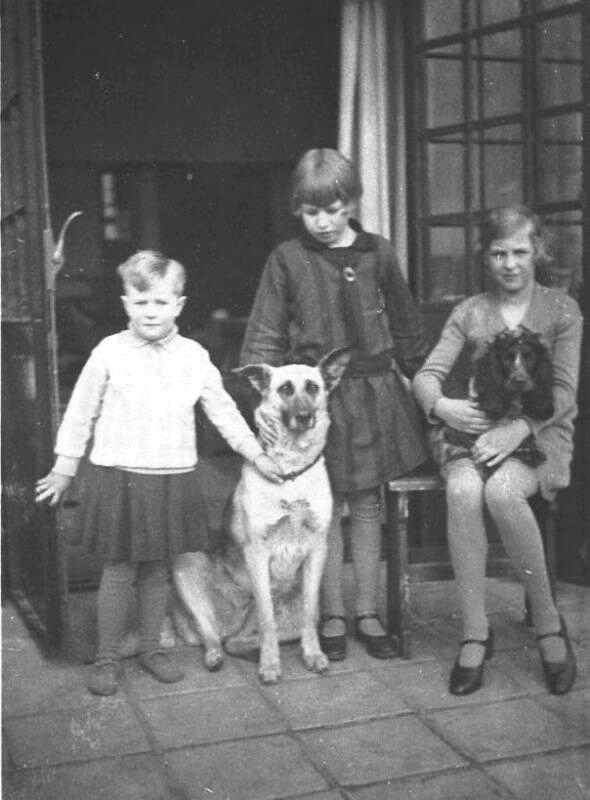
Difficult Images: Gender Identification #25

Figure 25.--A HBC reader has forwardedus this image from a family album. We know nothing about it at this time. It appears to be a Dutch or Flemish family, probably taken about 1930. Here the younger child at the left looks to us to be a boy. Thus unlike some of the other photographs in this section, our question is not gender identification. Rather we do not know why the boy is wearing a skirt. We would understand it in Scotland, but it seems unusual for the Netherlands or Flanders. The family name be Kort. Notice how the little boy is holding on to the wonderful German shepard.
|
A HBC reader has forwardedus this image from a family album. We know nothing about it at this time. It appears to be a Dutch or Flemish family, probably taken about 1930. Here the younger child at the left looks to us to be a boy. Thus unlike some of the other photographs in this section, our question is not gender identification. Rather we do not know why the boy is wearing a skirt. We would understand it in Scotland, but it seems unusual for the Netherlands or Flanders. The family name be Kort. Notice how the little boy is holding on to the wonderful German shepard.
A reader writes, "I think there can be very little question that the child on the left with the dog is a boy. His haircut is very different from those of his sisters. The skirt does seem a bit odd for the Netherlands, but perhaps there was some idea in the family to dress all the children pretty much alike. Note that they all wear long stockings. By the way, this photo is also good evidence for the increased length of long stockings during the period. The stockings all seem to be very long, especially those of the oldest girl. The stocking color is also worth noting--not black (as would have the case a decade earlier probably) but either beige or medium brown."
Another reader writes, "This is an interesting pic, especially if it were Dutch. I know of one place in the Netherlands were boys upto the age of 6 wore skirts and that is Marken, an island in the IJsselmeer (formerly the Zuiderzee). They certainly did so in the first quarter of the 20th century. However the boy lacks everything else that would make his outfit a traditional Marken folk costume.
Morover, his sisters (?) are wearing dresses which indicate middle class status, certainly not the fisherman population of Marken. I know of no place in Belgium were boys that age would have worn skirts during that period.
Another reader writes, "Kort certainly is a Dutch family name. It means "short". As a family name it is spelled different ways: Kort, de Kort, de Korte, de Corte. Each of these spellings tends to have a higher concentration in one or more regions. If it is "Kort" without the prefix, the family almost certainly hails from Rotterdam or the provinces north of the Rhine river. If it is "de Kort" their forebears have probably come from the old duchy of Brabant, encompassing today's Dutch province of Noord-Brabant, and the Belgian province of Antwerp, with an offshoot into the city of Rotterdam (Holland) and the Belgian province of Oost-Vlaanderen (East-Flanders). Of course migration, especially during the past 50 years, has somewhat "smudged" this pattern, but I think that in the 1920s abd 30s that it was still very much valid."
A French reader writes, "Maybe this little boy is wearing a smock under his pullover? What is sure, these children aren't French or Belgian. Here there are many reasons. Long dark stockings weren't in fashion. The look of the window too.
About little boys' fashions. It wasn't impossible to see in France 1940-50s a boy wearing a cardidan or a sweater above his smock, giving in this case the same look. Of course excepted without the long stockings. Inmany families boys quite often kept their smock after the school , and if the weather was chilly added a sweater.
The French smock were more popular as the photo are showing. Because, when the
photographer came to school, when the mothers were aware, they often dressed their boys up without smocks." Here our French reader may well be correct about the smock. We don't think this is a French photigraph. We do, however, think it might be Belgian. Remember that French styles were most common in the French speaking areas. This appears to be a photograph from the Dutch speaking Flemish area.
HBC

[Return to the Main difficult gender page]
[Introduction]
[Activities]
[Biographies]
[Chronology]
[Clothing styles]
[Countries]
[Gender]
[Girls]
[Bibliographies]
[Contributions]
[Essays]
[FAQs]
[Glossaries]
[Links]
[Satellites]
[Tools]
[Boys' Clothing Home]
Created: 9:52 PM 9/22/2005
Last updated: 6:30 PM 10/16/2005



